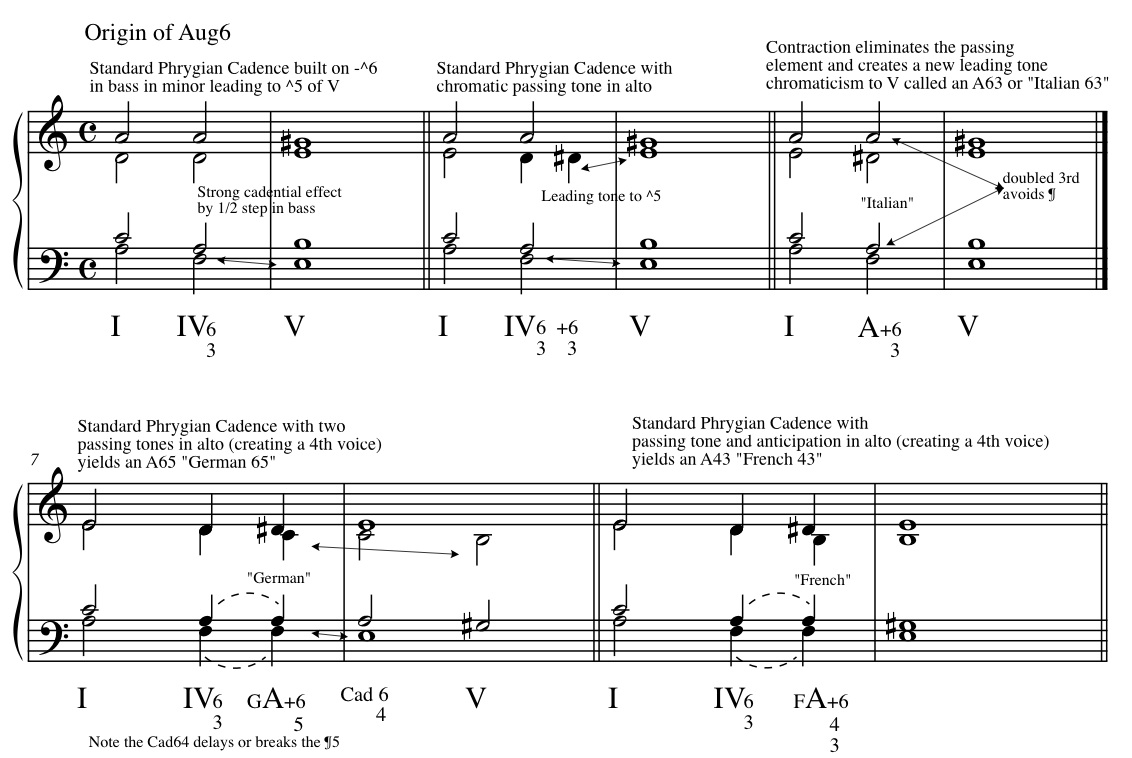|
Homework: Workbook
Chapter 29
Preliminaries all
Longer Assignments 3
Study & Analysis #5, 10, 13
or
Textbook Chapter 30 Preliminaries
1 all #2 c, d, a
Write 16 bars incorporating at
least 2 usages of textbook
preliminaries 1
Workbook Study & Analysis
#5, 10, 13
A Chromatic Preparation for V
In
chapter 27 we saw that the NII6 had a lowered -^2 that tended to
resolved down to the leading tone. We saw that its natural melodic
tendancy was to resolve by 1/2 step to ^1 and showed such a resolution
via the resolution of a NII6 though a cad64. The tendancy of a tone to
resolve, or lead, to its closest 1/2 step is now becoming quite
familiar to us. We have seen it with the standard LT, syntactic motion
such as -VII, V, I yielding -^7, ^7, ^1 and the chromatic alteration of
tones in applied dominants. We have seen such progessions as the
phrygian cadence (IV6-V in minor) lead into a cadence via half step. We
talked briefly in our discussion of the viiș7 that an enharmonic
respelling of that chord could lead us to a chord 1/2 step away from
any tone in the original viiș7. The power of the 1/2 step to lead the
ear, is a critical element in how we perceive music. Infact, its so
powerful that we call such movement by halfstep Leading Tone Chromaticism
1. Leading-tone chromaticism.
a. One very unique and important Leading Tone Chromatic movement is the Augmented 6th.
b. In general it is built on the -^6 and contains an Aug6th above (on +^4)
c. If we resolve the bass 1/2 step down and the Aug 6th 1/2 step up, we resolve into an octave on ^5
d. Note: The dissonant interval Aug 6 resolves UP. Why? We see that the
very tone that is dissonant to the bass is actually a leading tone to
the point of resolution. Therefore as a LT it will resolve up!
(interestingly since the Aug 6th chord resolves to a V it would be
possible to resolve the dissonant Aug 6 down to the chordal 7th of the
V7 ;-)
e. Interestingly, unlike an applied dominant, the Aug6th chord does not
diatonically belong to the chord of its resolution. Therefore, unlike
applied dominants the arrival of the resolution of the A6 does not
sound like a tonic
f. Since we know the -^6 can be implemented via Mixture into major
mode, the Aug 6 chord can be effective in either major or minor.
2. Contrapuntal Origin
a. We know from a phrygian cadence where the bass descends from -^6 to
^5 that the 1/2 step motion to ^5 leads very compellingly in a similar
manner as the LT 1/2 step motion to ^1
b. If we insert a chromatic passing tone between the IV6 -V of the phrygian cadence, we get a passing Aug 6
c. This passing Aug 6 became its own syntax around the time of Beethoven and, as such is referred to as the Aug 6 chord.
d. With a double passing tone, we transform the A6 into a 4 voice chord and get an Aug 653 (+653).
e. With a single passing tone and an anticipation, we transform the A6 into a 4 voice chord and get an Aug 643 (+643)
3-6. Geographical names
a. The geographical names listed below are meaningless. However they
have achieved wide acceptance amongst musicians so we will use them.
b. Italian 6: the basic 3 voice Augmented 63 chord. It should be noted that in 4 voices one should double the 3rd above the bass to avoid ¶s
c. German 65:
= the most common of the augmented 6th chords it contains the aug6th,
5th and 3rd above the bass on -^6. In order to avoid ¶5ths, this chord
will often resolve to V through a Cad 64. This will have the effect of
delaying the parallel motion.
d. French 43:
= another 4 voice augmented 6th chord but this one arrives by a
combination of a passing tone to +^4 and an anticipation of ^2. This
anticipation removes the possibilities of ¶5ths and therefore the
French 43 may or may not move to V via Cad64.

|